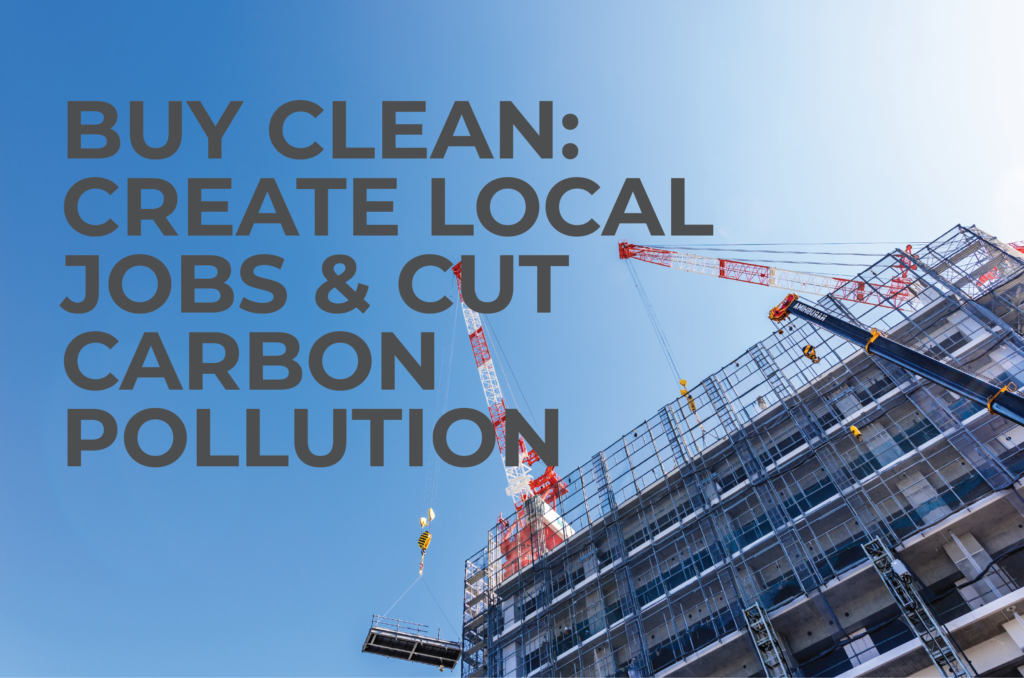Half of the carbon associated with new construction between now and 2050 will be from material manufacturing. Globally, the manufacture of construction materials accounts for over 11% of global carbon emissions.
Climate leaders, including policymakers, architects, engineers, and building owners, are working towards addressing this by creating buildings and infrastructure that take less carbon to build. Some actions include:
- Designing for material efficiency (use less)
- Designing for flexibility and renovation (reuse existing)
- Specifying materials that are less polluting (use cleaner)
The third point especially has seen a lot of attention recently. Manufacturers across the building industry are finding new and innovative ways to reduce their carbon footprint and thus the “embodied carbon” in their products.
Steel and concrete manufacturers are increasing their use of recycled materials, meaning their products are lower-carbon than alternatives that use only virgin (non-recycled) inputs.
A low-carbon cement known as “Portland limestone cement” has been developed which has 10% less carbon emissions than standard Portland cement.
Wood buildings are also having a resurgence, with building codes being updated to allow for taller and more ubiquitous use of mass timber techniques. In many cases, these mass timber buildings can have a carbon advantage over traditional building materials.
Construction material manufacturers are increasingly reporting the carbon footprint of their products by way of a document called an environmental product declaration, or EPD. Leading building owners and procurement teams are starting to require lower carbon products, documented by an EPD from the manufacturer showing the environmental profile, including the carbon footprint or “global warming potential” of the material.
California has enacted a policy called “Buy Clean” which requires EPDs to be submitted for certain material types on state-funded projects. By July 2021, the EPDs will need to show a carbon profile below a set point, meaning it must be a low carbon product.
Other jurisdictions are taking a whole-building approach. Vancouver has set a goal to reduce the total embodied carbon in construction by 40% by 2030. They will be using whole-building embodied carbon calculations and caps, as opposed to California’s material-specific approach.
Setting carbon thresholds on materials and buildings, to be demonstrated through EPDs or whole-building calculations, are laudable goals. But they aren’t easy. Each approach takes massives amounts of time, data, industry buy-in, calculation tools, standardized calculation methodology, and more. Many experts foresee material carbon efficiency as the next front in the battle to green construction, and that it will become regulated and managed in future building codes. However, it will take time for a standardized approach to emerge.
For those interested in an interim simplified approach, consider specifying materials from low-carbon jurisdictions. These are locations that have a high level of environmental regulations to limit pollution and energy use. These are also locations that have cleaner electricity grids. In general, a product manufactured in one of these low-carbon locations should have a lower embodied carbon footprint than a product manufactured in an area with less environmental control and a dirtier electricity grid powered by fossil fuels.
There are various ways that regions generate their electricity, each with a different carbon footprint. Some regions rely mainly on the combustion of fossil fuels such as coal and natural gas. Those locations have a relatively high carbon associated with their electricity. Other regions like BC and Quebec rely mainly on hydroelectric power which has a very low carbon footprint. Ontario uses a mix of hydroelectric, natural gas, and nuclear generation, with a relatively low combined carbon intensity.
The image below shows the relative carbon intensity of electricity in various states (blue) and provinces (red).
Based on the above, it can be seen that large parts of Canada (including three of the largest provinces of Ontario, BC, and Quebec) have a carbon advantage. This shows that shifting procurement to Canadian suppliers can support local jobs and cut carbon pollution.
Blue Green Canada’s new report, Buy Clean: How Public Construction Dollars Can Create Jobs and Cut Pollution, which Mantle Developments helped author, provides more information regarding this Canadian carbon advantage. The research found that metals in particular that are manufactured in Canada have a relatively low carbon footprint. The below figures show Canadian-manufactured steel and aluminum has roughly half the carbon footprint of products made south of the border. The gap grows even larger when compared to products manufactured in Asia and shipped from the other side of the planet.
Figures from Buy Clean: How Public Construction Dollars Can Create Jobs and Cut Pollution, January 2021, Blue Green Canada
Policymakers, designers, engineers, and building owners can use this information when specifying materials. Consider local materials or ones manufactured in low-carbon jurisdictions. This strategy can be a simple interim solution to use until more robust standardized product-specific environmental data is integrated into the procurement process.
.
Mantle Developments can help procure low-carbon materials for your construction project
Contact us for help, including understanding and using material-specific or whole-building carbon caps, or simplified jurisdiction-based procurement goals. We can help your team understand, develop, analyze and verify these goals from schematic design through construction and operation.

